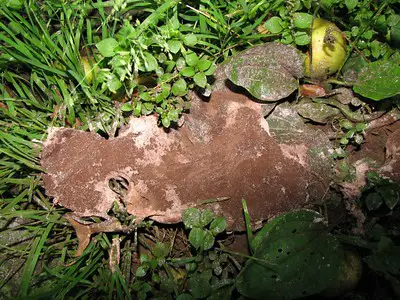
Many people are fortunate enough to have owned dogs in their lifetime but have never seen them vomit red or pink foam.
It’s natural for us to be hyper-aware of what’s coming in and out of our pet’s mouths, particularly since we cannot ask them how they’re feeling.
As dogs can be very independent and inquisitive, we cannot always keep an eye on them 24/7.
However, with the correct knowledge, we can develop the ability to spot a potential problem.
Why do dogs vomit bile? Most common reasons
It’s important to know the difference between vomit and regurgitation. If a dog has ingested something they shoudn’t have, they’ll quickly regurgitate the undigested item.
Vomiting can happen seemingly out of nowhere sometimes and is not always linked to food intake.
Bile generally has the colour of dark green or yellowish-brown. It’s noticeably different to vomit and regurgitated food.
Dogs can vomit bile for many different reasons.
Gastrointestinal disease
This happens when a dog’s stomach and intestines become inflamed. It’s very difficult to find the cause without taking your dog to the vet. The inflammation can be the result of infections from parasites or bacteria, poisonings or toxins, kidney disease or cancer.
Bilious vomiting syndrome
It’s natural for dogs to produce bile, which is produced in the liver and stored in the gallbladder. This syndrome can occur when the bile leaks into the small intestine. Overeating or overdrinking are the most common causes of this.
Placing your dog on a low-fat, high-fibre diet can prevent this from happening again.
Pancreatitis
Pancreatitis is a condition that can cause serious harm to a dog. It can even be fatal. The pancreas becomes inflamed for reasons such as diabetes or obesity.
Enzymes are normally produced in the pancreas to aid digestion. However, when these enzymes begin to produce outside of the organ, this can cause devastating damage to the area around it.
Any dog rushed to the vets with pancreatitis would likely be given an intravenous drip.
Allergies
When a dog vomits bile, it indicates the stomach has been emptied. The gastric acids in bile irritate the empty stomach lining, causing vomiting. It may be worth considering whether you’ve changed diets recently, or whether the dog may have eaten something they shouldn’t have.
Dogs can have an allergy to anything from chicken to corn.
Stress or anxiety
Similarly to allergies, a dog may have avoided eating for a long period due to being worried or stressed. In turn, the gastric acids irritate the empty stomach lining and the dog is sick.
Vomiting due to stress can actually manifest for many different reasons, such as separation anxiety.
How is vomiting bile different from vomiting food or ‘foreign objects’?
It’s common for dogs to vomit after eating something they shouldn’t have. This means simply they’ve overeaten or the item, especially a toxin or ‘foreign object’, has been rejected by the stomach.
Unfortunately, bile can be an indicator of something more serious happening to the body.
Any bile that is expelled should be reported to a vet. Vomiting once does not necessarily have to be a cause for concern, but bile reflux is definitely an indicator you need to find out what’s happening in your dog’s body.
In vomiting bile, the dog is also at risk of becoming dehydrated. Bile is 85% water, so the dog must replace their lost water levels as soon as possible.
Excessive bile vomiting can cause damage to the stomach and oesophagus.
Green bile can also be a sign that there’s a blockage in the bowel.
Why do dogs vomit pink or red foam?
Pink frothy liquid may have been coughed up from the lungs, rather than vomited from the stomach. There can be a couple of signs which indicate this. Liquid from the lungs looks like mucus and will not be as acidic as vomit.
Red vomit is a sign your dog is coughing up blood. This is called hematemesis. This can be caused by any gastrointestinal issue, poisoning, trauma or an ulcer.
Any sign of red in vomit should warrant a call to the vets. Even if it’s nothing serious, it’s still important to get this ruled out.
As a rule of thumb, the darker the red, the longer the blood has been in the stomach.
What other symptoms might you see together with the pink foam?
This can really vary based on the cause of the pink foam.
Cancer or gastrointestinal issues would be accompanied by diarrhoea. Lung cancer in particular can cause your dog to display weight loss, lethargy, loss of appetite, as well as incessant coughing.
Constant panting as well as struggling to breathe can also be a sign of heart failure.
For poisoning, you can expect seizures, convulsions and agitation.
It’s uncommon for pink foam to not be a serious cause for concern, so it must always be taken seriously.
How can it be treated?
Firstly, a veterinarian needs to find the root cause of the vomiting. Once they have an answer, they can begin a course of treatment.
If the dog has gastritis, the dog may have to fast for up to 48 hours. If an allergy is suspected, the veterinarian may stagger out their current diet to find the culprit food.
Herbal remedies are also very useful:
Chamomile
Chamomile helps reduce inflammation in the digestive tract. It soothes any aches and burns in the stomach, as well as prevents acid and bile reflux.
Liquorice
Liquorice has a cooling effect on the stomach so can therefore be used for heartburn as well as bile reflux.
Marshmallow root
Marshmallow root coats and soothes the gastrointestinal tract. It also helps to bring down any heat and inflammation.
Meadowsweet
Meadowsweet is for those dogs with high acid levels in their stomach.
All herbal supplements would have a low dosage and be dropped into the dog’s food using a measured dropper.
Sometimes, a dog can vomit bile in the morning due to waking with an empty stomach. In this circumstance, the dog may receive more regular, smaller meals throughout the day, or a late meal at bedtime.
When is dog vomiting serious?
Dark red blood in particular is a very serious medical emergency and must be taken seriously. Vomiting is a vital sign of what’s going on internally and as such, we should pay attention to it.
A dog vomiting white foam is also enough to warrant an emergency trip to the vets.
Any dog vomit must be carefully examined for anything unusual. If something does not look right, get a second opinion.
When is a dog vomiting nothing to worry about?
I’m sure we’ve all seen our dogs vomit sometimes, particularly when they’ve eaten something they shouldn’t have. So too when they’ve overeaten. There’s a reason the day after Thanksgiving or the Christmas period always sees a huge spike in vet calls!
Any dog who vomits should be closely observed in the following hours or days. Be mindful that the dog may not always vomit in plain sight. They may retreat to a quiet spot in the garden or even bury it.
As always, it’s best to exercise caution here and phone a veterinarian if you have any concerns.
Keep a close eye too on any other symptoms your dog may be displaying.
What are other common colours of dog vomit and what do they mean?
Yellow vomit
This is a common issue. Bile is very alkaline so it helps to neutralise the acidic stomach contents. In doing so, it also prevents the vulnerable lining of the small intestine.
The acidic content of the stomach then passes through what’s called a pyloric valve, which connects the stomach and small intestine. The pyloric sphincter then closes.
However, if it doesn’t close, the bile leaks back into the stomach and reacts with the acid. This then causes the yellow bile, which is typical of the less serious reasons for bile expulsion, such as an empty stomach.
Red vomit
Red sick is almost always blood and your dog must be seen by a veterinarian straight away.
A light colour could indicate inflammation, whereas dark blood is indicative of a long-term issue, such as an ulcer.
White vomit
White vomit is likely to be just an upset stomach.
If it’s white bile, this will require urgent medical attention. This could point to gastrointestinal concerns and must be treated as an emergency.
Dark brown vomit
It’s likely your dog has ingested too many faeces. However, if the vomiting is excessive, it could be an intestinal blockage.
Black vomit
This is a difficult one to diagnose yourself, so you must be careful. Jet black vomit could be simple ingestion of dirt, however, you must check whether the colour is in fact black or dark red.
Dark red in vomit is a sign of something serious and your dog must be admitted to a veterinarian immediately.
Also, the same applies to a texture consistent with coffee granules.
Works Cited
Farricelli, Adrienne. “What Are the Causes of My Dog Vomiting Bile?” PetHelpful, 20 April 2022, https://pethelpful.com/dogs/-Causes-of-Dog-Vomiting-Bile. Accessed 8 June 2022.
Hogan, Rita. “Is Your Dog Throwing Up Yellow Vomit?” Dogs Naturally, https://www.dogsnaturallymagazine.com/dog-vomiting-yellow-bile/. Accessed 8 June 2022.
“Pancreatitis in Dogs – Symptoms, Treatment, & Prevention.” American Kennel Club, https://www.akc.org/expert-advice/health/pancreatitis-in-dogs/. Accessed 8 June 2022.
“What Colour is your Dog’s Vomit & What Does it Mean?” My Family Vets, https://www.myfamilyvets.co.uk/dog-vomit-colour-guide. Accessed 8 June 2022.





